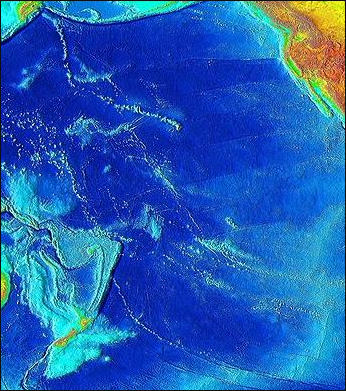PLATE TECTONICS

Himalayan mountain pushed up
plate tectonics Many geological features and phenomena are explained in terms of plate tectonics, a geological theory that emerged in the 19th century, gained credibility in the 1970s and now is generally accepted as fact. According to theory the Earth's surface is fragmented into large plates that can range in size from a small country to a continent. These plates float along the mantel under the Earth's surface. In places were plates meets faults form and earthquakes occur. [Source: Mostly from the USGS article “This Dynamic Earth, The Story of Plate Tectonics” (1996) by Jaquelyne Kious and Robert I. Tilling pubs.usgs.gov]
Craig Robert Martin wrote in The Conversation:“Tectonic plates make up the surface of Earth, and they’re constantly in motion – drifting at the imperceptibly slow pace of just a few centimeters each year. Oceanic plates are colder and denser than the mantle beneath them, so they sink downward into it at subduction zones. The sinking edge of the ocean plate drags the ocean floor along behind it like a conveyor belt, pulling the continents toward each other. When the entire ocean plate disappears into the mantle, the continents on either side plow into each other with enough force to uplift great mountain belts, like the Himalayas. [Source: Craig Robert Martin, Ph.D. Student in Earth, Atmospheric and Planetary Sciences, Massachusetts Institute of Technology, The Conversation, November 3, 2020]
Before the advent of plate tectonics some people already believed that the present-day continents were the fragmented pieces of preexisting larger landmasses ("supercontinents"). According to the continental drift theory, the supercontinent Pangaea began to break up about 225-200 million years ago, eventually fragmenting into the continents as we know them today. The break-up of the supercontinent Pangaea (meaning "all lands" in Greek), which figured prominently in the theory of continental drift — the forerunner to the theory of plate
In the early 1960s, the emergence of the theory of plate tectonics started a revolution in the earth sciences. Since then, scientists have verified and refined this theory, and now have a much better understanding of how our planet has been shaped by plate-tectonic processes. We now know that, directly or indirectly, plate tectonics influences nearly all geologic processes, past and present. Indeed, the notion that the entire Earth's surface is continually shifting has profoundly changed the way we view our world. The theory has unified the study of the Earth by drawing together many branches of the earth sciences, from paleontology (the study of fossils) to seismology (the study of earthquakes). It has provided explanations to questions that scientists had speculated upon for centuries — such as why earthquakes and volcanic eruptions occur in very specific areas around the world, and how and why great mountain ranges like the Alps and Himalayas formed.
How Plate Tectonics Works
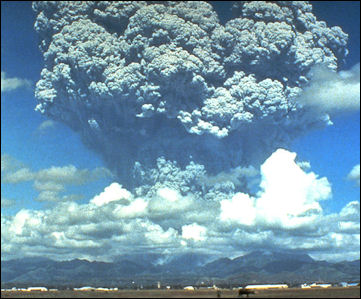
destructive Pinatubo eruption near Manila
caused by plate tectonicsPhilip Heron wrote in The Conversation: “Earth’s crust and top part of the mantle (the next layer in toward the core of our planet) run about 150 kilometers deep. Together, they’re called the lithosphere and make up the “plates” in plate tectonics. We now know there are 15 major plates that cover the planet’s surface, moving at around the speed at which our fingernails grow. [Source: Philip Heron, Postdoctoral Fellow in Geodynamics, University of Toronto, The Conversation, July 5, 2016]
“Based on radiometric dating of rocks, we know that no ocean is more than 200 million years old, though our continents are much older. The oceans’ opening and closing process – called the Wilson cycle – explains how the Earth’s surface evolves. A continent breaks up due to changes in the way molten rock in the Earth’s interior is flowing. That in turn acts on the lithosphere, changing the direction plates move. This is how, for instance, South America broke away from Africa. The next step is continental drift, sea-floor spreading, ocean formation – and hello, Atlantic Ocean. In fact, the Atlantic is still opening, generating new plate material in the middle of the ocean and making the flight from New York to London a few inches longer each year.
Oceans close when their tectonic plate sinks beneath another, a process geologists call subduction. Off the Pacific Northwest coast of the United States, the ocean is slipping under the continent and into the mantle below the lithosphere, creating in slow motion Mount St Helens and the Cascade mountain range. In addition to undergoing spreading (construction) and subduction (destruction), plates can simply rub up against each other - usually generating large earthquakes. These interactions, also discovered by Tuzo Wilson back in the 1960s, are termed “conservative.” All three processes occur at the edges of plate boundaries.
Basic Components of Plate Tectonics
In geologic terms, a plate is a large, rigid slab of solid rock. The word tectonics comes from the Greek root "to build." Putting these two words together, we get the term plate tectonics, which refers to how the Earth's surface is built of plates. The theory of plate tectonics states that the Earth's outermost layer is fragmented into a dozen or more large and small plates that are moving relative to one another as they ride atop hotter, more mobile material.
At subduction zones two plates collide head on, with one plate going over the top, forcing the other one down. In some cases the motion produces a descending convection current that sucks down the ocean floor. In these places deep seas trenches form; mountain building activity and earthquakes occur; and millions of tons of rock sink into the crust everyday. Subduction faults are usually angled at about 10 to 15 percent and often located where major oceans and continents meet. Where ocean crust, pushed down by the weigh of ocean water, is shoved under the thick crust of continents, the rock is heated, causing water and gases to bubble out. As they rise they melt the rock above it, creating magma that can fuel volcanoes. Subduction zones are also described as convergent boundaries (See Below).
Rift zones are where the Earth's tectonic plates are pulled apart as new material rises from inside the Earth, sometimes volcanically, creating millions of tons of new crust every day and causing the plates to spread.. Mountains and volcanoes rise form here as they do in subduction zones but for different reasons. Most rift zones are in the middle of the oceans. The Mid-Atlantic Ridge, which runs north-to-south the entire length of the Atlantic is one. Rift zones are also described as divergent boundaries (See Below).

Tectonic plate boundaries
What generates all this activity is the slow release of heat from the interior of the Earth. This heat is produced by the radioactive decay of elements such as uranium, potassium and thorium. The heats causes rock to liquify into magma and creates pressures that makes the plates move.
Philip Heron wrote in The Conversation: “So far, amazingly, Earth is the only planet we know of that has plate tectonics. In our solar system, for example, Venus is often considered Earth’s twin - just with a hellish climate and complete lack of plate tectonics. Incredibly, the ability of a planet to generate complex life is inextricably linked to plate tectonics. A gridlocked planetary surface has helped produce Venus’ inhabitable toxic atmosphere of 96 percent CO . On Earth, subduction helps push carbon down into the planet’s interior and out of the atmosphere. [Source: Philip Heron, Postdoctoral Fellow in Geodynamics, University of Toronto, The Conversation, July 5, 2016]
“It’s still difficult to explain how complex life exploded all over our world 500 million years ago, but the processes of removing carbon dioxide from the atmosphere is further helped by continental coverage. An exceptionally slow process starts with carbon dioxide mixing with rain water to wear down continental rocks. This combination can form carbon-rich limestone that subsequently washes away to the ocean floor. The long removal processes (even for geologic time) eventually could create a more breathable atmosphere. It just took 3 billion years of plate tectonic processes to get the right carbon balance for life on Earth.”
Roots of the Theory of Plate Tectonics
Why is the Earth so restless? What causes the ground to shake violently, volcanoes to erupt with explosive force, and great mountain ranges to rise to incredible heights? Scientists, philosophers, and theologians have wrestled with questions such as these for centuries. Until the 1700s, most Europeans thought that a Biblical Flood played a major role in shaping the Earth's surface. This way of thinking was known as "catastrophism," and geology (the study of the Earth) was based on the belief that all earthly changes were sudden and caused by a series of catastrophes. However, by the mid-19th century, catastrophism gave way to "uniformitarianism," a new way of thinking centered around the "Uniformitarian Principle" proposed in 1785 by James Hutton, a Scottish geologist. This principle is commonly stated as follows: The present is the key to the past. Those holding this viewpoint assume that the geologic forces and processes — gradual as well as catastrophic — acting on the Earth today are the same as those that have acted in the geologic past.
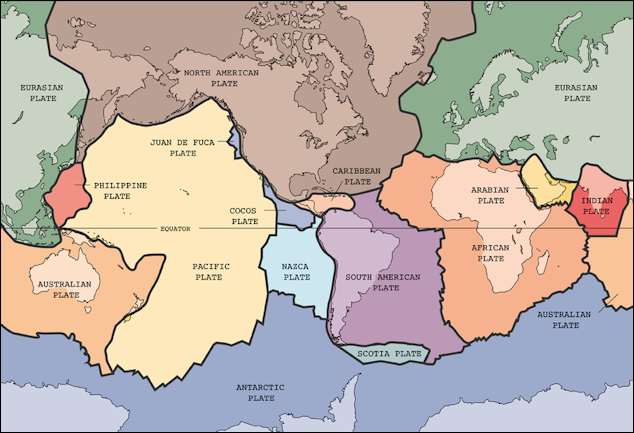
Tectonic plates
The belief that continents have not always been fixed in their present positions was suspected long before the 20th century; this notion was first suggested as early as 1596 by the Dutch map maker Abraham Ortelius in his work Thesaurus Geographicus. Ortelius suggested that the Americas were "torn away from Europe and Africa . . . by earthquakes and floods" and went on to say: "The vestiges of the rupture reveal themselves, if someone brings forward a map of the world and considers carefully the coasts of the three [continents]." Ortelius' idea surfaced again in the 19th century. In 1858, geographer Antonio Snider-Pellegrini made these two maps showing his version of how the American and African continents may once have fit together, then later separated.
Alfred Lothar Wegener and Continental Drift
However, it was not until 1912 that the idea of moving continents was seriously considered as a full-blown scientific theory — called Continental Drift — introduced in two articles published by a 32-year-old German meteorologist named Alfred Lothar Wegener. He contended that, around 200 million years ago, the supercontinent Pangaea began to split apart. Alexander Du Toit, Professor of Geology at Witwatersrand University and one of Wegener's staunchest supporters, proposed that Pangaea first broke into two large continental landmasses, Laurasia in the northern hemisphere and Gondwanaland in the southern hemisphere. Laurasia and Gondwanaland then continued to break apart into the various smaller continents that exist today.
Wegener's theory was based in part on what appeared to him to be the remarkable fit of the South American and African continents, first noted by Abraham Ortelius three centuries earlier. Wegener was also intrigued by the occurrences of unusual geologic structures and of plant and animal fossils found on the matching coastlines of South America and Africa, which are now widely separated by the Atlantic Ocean. He reasoned that it was physically impossible for most of these organisms to have swum or have been transported across the vast oceans. To him, the presence of identical fossil species along the coastal parts of Africa and South America was the most compelling evidence that the two continents were once joined.
In Wegener's mind, the drifting of continents after the break-up of Pangaea explained not only the matching fossil occurrences but also the evidence of dramatic climate changes on some continents. For example, the discovery of fossils of tropical plants (in the form of coal deposits) in Antarctica led to the conclusion that this frozen land previously must have been situated closer to the equator, in a more temperate climate where lush, swampy vegetation could grow. Other mismatches of geology and climate included distinctive fossil ferns (Glossopteris) discovered in now-polar regions, and the occurrence of glacial deposits in present-day arid Africa, such as the Vaal River valley of South Africa.
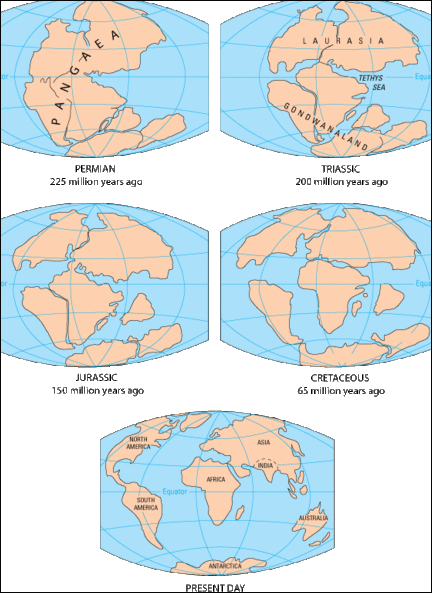
Pangaea to presentThe theory of continental drift would become the spark that ignited a new way of viewing the Earth. But at the time Wegener introduced his theory, the scientific community firmly believed the continents and oceans to be permanent features on the Earth's surface. Not surprisingly, his proposal was not well received, even though it seemed to agree with the scientific information available at the time. A fatal weakness in Wegener's theory was that it could not satisfactorily answer the most fundamental question raised by his critics: What kind of forces could be strong enough to move such large masses of solid rock over such great distances? Wegener suggested that the continents simply plowed through the ocean floor, but Harold Jeffreys, a noted English geophysicist, argued correctly that it was physically impossible for a large mass of solid rock to plow through the ocean floor without breaking up.
Undaunted by rejection, Wegener devoted the rest of his life to doggedly pursuing additional evidence to defend his theory. He froze to death in 1930 during an expedition crossing the Greenland ice cap, but the controversy he spawned raged on. However, after his death, new evidence from ocean floor exploration and other studies rekindled interest in Wegener's theory, ultimately leading to the development of the theory of plate tectonics.
Mapping the Ocean Floor
About two thirds of the Earth's surface lies beneath the oceans. Before the 19th century, the depths of the open ocean were largely a matter of speculation, and most people thought that the ocean floor was relatively flat and featureless. However, as early as the 16th century, a few intrepid navigators, by taking soundings with hand lines, found that the open ocean can differ considerably in depth, showing that the ocean floor was not as flat as generally believed. Oceanic exploration during the next centuries dramatically improved our knowledge of the ocean floor. We now know that most of the geologic processes occurring on land are linked, directly or indirectly, to the dynamics of the ocean floor.
"Modern" measurements of ocean depths greatly increased in the 19th century, when deep-sea line soundings (bathymetric surveys) were routinely made in the Atlantic and Caribbean. In 1855, a bathymetric chart published by U.S. Navy Lieutenant Matthew Maury revealed the first evidence of underwater mountains in the central Atlantic (which he called "Middle Ground"). This was later confirmed by survey ships laying the trans-Atlantic telegraph cable. Our picture of the ocean floor greatly sharpened after World War I (1914-18), when echo-sounding devices — primitive sonar systems — began to measure ocean depth by recording the time it took for a sound signal (commonly an electrically generated "ping") from the ship to bounce off the ocean floor and return. Time graphs of the returned signals revealed that the ocean floor was much more rugged than previously thought. Such echo-sounding measurements clearly demonstrated the continuity and roughness of the submarine mountain chain in the central Atlantic (later called the Mid-Atlantic Ridge) suggested by the earlier bathymetric measurements.
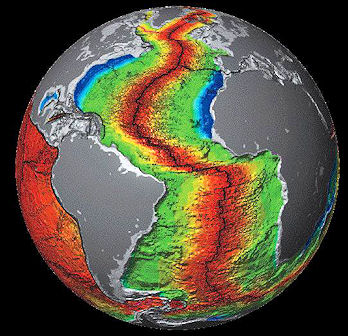
Atlantic Oceanic Crust In 1947, seismologists on the U.S. research ship Atlantis found that the sediment layer on the floor of the Atlantic was much thinner than originally thought. Scientists had previously believed that the oceans have existed for at least 4 billion years, so therefore the sediment layer should have been very thick. Why then was there so little accumulation of sedimentary rock and debris on the ocean floor? The answer to this question, which came after further exploration, would prove to be vital to advancing the concept of plate tectonics.
In the 1950s, oceanic exploration greatly expanded. Data gathered by oceanographic surveys conducted by many nations led to the discovery that a great mountain range on the ocean floor virtually encircled the Earth. Called the global mid-ocean ridge, this immense submarine mountain chain — more than 50,000 kilometers (km) long and, in places, more than 800 km across — zig-zags between the continents, winding its way around the globe like the seam on a baseball. Rising an average of about 4,500 meters(m) above the sea floor, the mid-ocean ridge overshadows all the mountains in the United States except for Mount McKinley (Denali) in Alaska (6,194 m). Though hidden beneath the ocean surface, the global mid-ocean ridge system is the most prominent topographic feature on the surface of our planet.
Magnetic Striping and Polar Reversals
Beginning in the 1950s, scientists, using magnetic instruments (magnetometers) adapted from airborne devices developed during World War II to detect submarines, began recognizing odd magnetic variations across the ocean floor. This finding, though unexpected, was not entirely surprising because it was known that basalt — the iron-rich, volcanic rock making up the ocean floor— contains a strongly magnetic mineral (magnetite) and can locally distort compass readings. This distortion was recognized by Icelandic mariners as early as the late 18th century. More important, because the presence of magnetite gives the basalt measurable magnetic properties, these newly discovered magnetic variations provided another means to study the deep ocean floor.
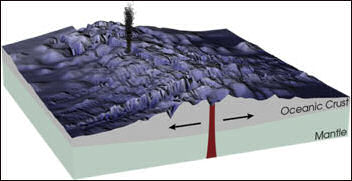
seafloor spreading A theoretical model of the formation of magnetic striping. New oceanic crust forming continuously at the crest of the mid-ocean ridge cools and becomes increasingly older as it moves away from the ridge crest with seafloor spreading (see text): a. the spreading ridge about 5 million years ago; b. about 2 to 3 million years ago; and c. present-day.
Early in the 20th century, paleomagnetists (those who study the Earth's ancient magnetic field) — such as Bernard Brunhes in France (in 1906) and Motonari Matuyama in Japan (in the 1920s) — recognized that rocks generally belong to two groups according to their magnetic properties. One group has so-called normal polarity, characterized by the magnetic minerals in the rock having the same polarity as that of the Earth's present magnetic field. This would result in the north end of the rock's "compass needle" pointing toward magnetic north. The other group, however, has reversed polarity, indicated by a polarity alignment opposite to that of the Earth's present magnetic field. In this case, the north end of the rock's compass needle would point south. How could this be? This answer lies in the magnetite in volcanic rock. Grains of magnetite — behaving like little magnets — can align themselves with the orientation of the Earth's magnetic field. When magma (molten rock containing minerals and gases) cools to form solid volcanic rock, the alignment of the magnetite grains is "locked in," recording the Earth's magnetic orientation or polarity (normal or reversed) at the time of cooling.
As more and more of the seafloor was mapped during the 1950s, the magnetic variations turned out not to be random or isolated occurrences, but instead revealed recognizable patterns. When these magnetic patterns were mapped over a wide region, the ocean floor showed a zebra-like pattern. Alternating stripes of magnetically different rock were laid out in rows on either side of the mid-ocean ridge: one stripe with normal polarity and the adjoining stripe with reversed polarity. The overall pattern, defined by these alternating bands of normally and reversely polarized rock, became known as magnetic striping.
Seafloor Spreading and Recycling of Oceanic Crust
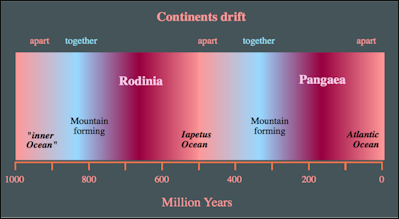
Wilson cycle The discovery of magnetic striping naturally prompted more questions: How does the magnetic striping pattern form? And why are the stripes symmetrical around the crests of the mid-ocean ridges? These questions could not be answered without also knowing the significance of these ridges. In 1961, scientists began to theorize that mid-ocean ridges mark structurally weak zones where the ocean floor was being ripped in two lengthwise along the ridge crest. New magma from deep within the Earth rises easily through these weak zones and eventually erupts along the crest of the ridges to create new oceanic crust. This process, later called seafloor spreading, operating over many millions of years has built the 50,000 km-long system of mid-ocean ridges.
This hypothesis was supported by several lines of evidence: (1) at or near the crest of the ridge, the rocks are very young, and they become progressively older away from the ridge crest; (2) the youngest rocks at the ridge crest always have present-day (normal) polarity; and (3) stripes of rock parallel to the ridge crest alternated in magnetic polarity (normal-reversed-normal, etc.), suggesting that the Earth's magnetic field has flip-flopped many times. By explaining both the zebralike magnetic striping and the construction of the mid-ocean ridge system, the seafloor spreading hypothesis quickly gained converts and represented another major advance in the development of the plate-tectonics theory. Furthermore, the oceanic crust now came to be appreciated as a natural "tape recording" of the history of the reversals in the Earth's magnetic field.
Additional evidence of seafloor spreading came from an unexpected source: petroleum exploration. In the years following World War II, continental oil reserves were being depleted rapidly and the search for offshore oil was on. To conduct offshore exploration, oil companies built ships equipped with a special drilling rig and the capacity to carry many kilometers of drill pipe. This basic idea later was adapted in constructing a research vessel, named the Glomar Challenger, designed specifically for marine geology studies, including the collection of drill-core samples from the deep ocean floor. In 1968, the vessel embarked on a year-long scientific expedition, criss-crossing the Mid-Atlantic Ridge between South America and Africa and drilling core samples at specific locations. When the ages of the samples were determined by paleontologic and isotopic dating studies, they provided the clinching evidence that proved the seafloor spreading hypothesis.
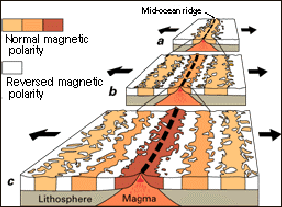
Oceanic Stripe Magnetic
Anomalies SchemeA profound consequence of seafloor spreading is that new crust was, and is now, being continually created along the oceanic ridges. This idea found great favor with some scientists who claimed that the shifting of the continents can be simply explained by a large increase in size of the Earth since its formation. However, this so-called "expanding Earth" hypothesis was unsatisfactory because its supporters could offer no convincing geologic mechanism to produce such a huge, sudden expansion. Most geologists believe that the Earth has changed little, if at all, in size since its formation 4.6 billion years ago, raising a key question: how can new crust be continuously added along the oceanic ridges without increasing the size of the Earth?
This question particularly intrigued Harry H. Hess, a Princeton University geologist and a Naval Reserve Rear Admiral, and Robert S. Dietz, a scientist with the U.S. Coast and Geodetic Survey who first coined the term seafloor spreading. Dietz and Hess were among the small handful who really understood the broad implications of sea floor spreading. If the Earth's crust was expanding along the oceanic ridges, Hess reasoned, it must be shrinking elsewhere. He suggested that new oceanic crust continuously spread away from the ridges in a conveyor belt-like motion. Many millions of years later, the oceanic crust eventually descends into the oceanic trenches — very deep, narrow canyons along the rim of the Pacific Ocean basin. According to Hess, the Atlantic Ocean was expanding while the Pacific Ocean was shrinking. As old oceanic crust was consumed in the trenches, new magma rose and erupted along the spreading ridges to form new crust. In effect, the ocean basins were perpetually being "recycled," with the creation of new crust and the destruction of old oceanic lithosphere occurring simultaneously. Thus, Hess' ideas neatly explained why the Earth does not get bigger with sea floor spreading, why there is so little sediment accumulation on the ocean floor, and why oceanic rocks are much younger than continental rocks.
Plate Tectonics Movement and Boundaries
Scientists now have a fairly good understanding of how the plates move and how such movements relate to earthquake activity. Most movement occurs along narrow zones between plates where the results of plate-tectonic forces are most evident.
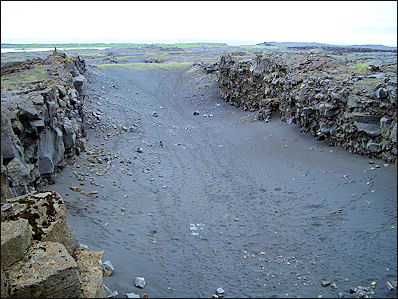
Gap between continents on Iceland There are four types of plate boundaries: 1) Divergent boundaries — where new crust is generated as the plates pull away from each other. 2) Convergent boundaries — where crust is destroyed as one plate dives under another. 3) Transform boundaries — where crust is neither produced nor destroyed as the plates slide horizontally past each other. 4) Plate boundary zones — broad belts in which boundaries are not well defined and the effects of plate interaction are unclear.
The size of the Earth has not changed significantly during the past 600 million years, and very likely not since shortly after its formation 4.6 billion years ago. The Earth's unchanging size implies that the crust must be destroyed at about the same rate as it is being created, as Harry Hess surmised. Such destruction (recycling) of crust takes place along convergent boundaries where plates are moving toward each other, and sometimes one plate sinks (is subducted) under another. The location where sinking of a plate occurs is called a subduction zone.
The type of convergence — called by some a very slow "collision" — that takes place between plates depends on the kind of lithosphere involved. Convergence can occur between an oceanic and a largely continental plate, or between two largely oceanic plates, or between two largely continental plates.
Divergent Plate Boundaries
Divergent boundaries occur along spreading centers where plates are moving apart and new crust is created by magma pushing up from the mantle. Picture two giant conveyor belts, facing each other but slowly moving in opposite directions as they transport newly formed oceanic crust away from the ridge crest.
Perhaps the best known of the divergent boundaries is the Mid-Atlantic Ridge. This submerged mountain range, which extends from the Arctic Ocean to beyond the southern tip of Africa, is but one segment of the global mid-ocean ridge system that encircles the Earth. The rate of spreading along the Mid-Atlantic Ridge averages about 2.5 centimeters per year (cm/yr), or 25 km in a million years. This rate may seem slow by human standards, but because this process has been going on for millions of years, it has resulted in plate movement of thousands of kilometers. Seafloor spreading over the past 100 to 200 million years has caused the Atlantic Ocean to grow from a tiny inlet of water between the continents of Europe, Africa, and the Americas into the vast ocean that exists today.
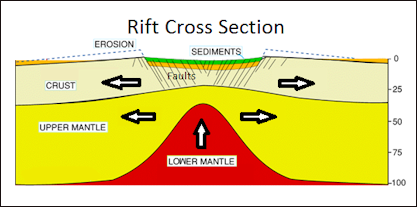
Rift cross section The volcanic country of Iceland, which straddles the Mid-Atlantic Ridge, offers scientists a natural laboratory for studying on land the processes also occurring along the submerged parts of a spreading ridge. Iceland is splitting along the spreading center between the North American and Eurasian Plates, as North America moves westward relative to Eurasia.
The consequences of plate movement are easy to see around Krafla Volcano, in the northeastern part of Iceland. Here, existing ground cracks have widened and new ones appear every few months. From 1975 to 1984, numerous episodes of rifting (surface cracking) took place along the Krafla fissure zone. Some of these rifting events were accompanied by volcanic activity; the ground would gradually rise 1-2 meters before abruptly dropping, signalling an impending eruption. Between 1975 and 1984, the displacements caused by rifting totalled about 7 meters.
In East Africa, spreading processes have already torn Saudi Arabia away from the rest of the African continent, forming the Red Sea. The actively splitting African Plate and the Arabian Plate meet in what geologists call a triple junction, where the Red Sea meets the Gulf of Aden. A new spreading center may be developing under Africa along the East African Rift Zone. When the continental crust stretches beyond its limits, tension cracks begin to appear on the Earth's surface. Magma rises and squeezes through the widening cracks, sometimes to erupt and form volcanoes. The rising magma, whether or not it erupts, puts more pressure on the crust to produce additional fractures and, ultimately, the rift zone.
East Africa may be the site of the Earth's next major ocean. Plate interactions in the region provide scientists an opportunity to study first hand how the Atlantic may have begun to form about 200 million years ago. Geologists believe that, if spreading continues, the three plates that meet at the edge of the present-day African continent will separate completely, allowing the Indian Ocean to flood the area and making the easternmost corner of Africa (the Horn of Africa) a large island.
Oceanic-Continental Convergence

Active Margin If by magic we could pull a plug and drain the Pacific Ocean, we would see a most amazing sight — a number of long narrow, curving trenches thousands of kilometers long and 8 to 10 km deep cutting into the ocean floor. Trenches are the deepest parts of the ocean floor and are created by subduction.
Off the coast of South America along the Peru-Chile trench, the oceanic Nazca Plate is pushing into and being subducted under the continental part of the South American Plate. In turn, the overriding South American Plate is being lifted up, creating the towering Andes mountains, the backbone of the continent. Strong, destructive earthquakes and the rapid uplift of mountain ranges are common in this region. Even though the Nazca Plate as a whole is sinking smoothly and continuously into the trench, the deepest part of the subducting plate breaks into smaller pieces that become locked in place for long periods of time before suddenly moving to generate large earthquakes. Such earthquakes are often accompanied by uplift of the land by as much as a few meters.
On 9 June 1994, a magnitude-8.3 earthquake struck about 320 km northeast of La Paz, Bolivia, at a depth of 636 km. This earthquake, within the subduction zone between the Nazca Plate and the South American Plate, was one of deepest and largest subduction earthquakes recorded in South America. Fortunately, even though this powerful earthquake was felt as far away as Minnesota and Toronto, Canada, it caused no major damage because of its great depth.
Oceanic-continental convergence also sustains many of the Earth's active volcanoes, such as those in the Andes and the Cascade Range in the Pacific Northwest. The eruptive activity is clearly associated with subduction, but scientists vigorously debate the possible sources of magma: Is magma generated by the partial melting of the subducted oceanic slab, or the overlying continental lithosphere, or both?
Oceanic-Oceanic Convergence
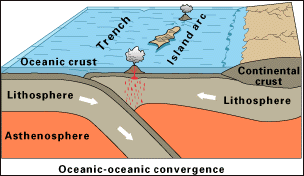
Oceanic-oceanic convergence As with oceanic-continental convergence, when two oceanic plates converge, one is usually subducted under the other, and in the process a trench is formed. The Marianas Trench (paralleling the Mariana Islands), for example, marks where the fast-moving Pacific Plate converges against the slower moving Philippine Plate. The Challenger Deep, at the southern end of the Marianas Trench, plunges deeper into the Earth's interior (nearly 11,000 m) than Mount Everest, the world's tallest mountain, rises above sea level (about 8,854 m).
Subduction processes in oceanic-oceanic plate convergence also result in the formation of volcanoes. Over millions of years, the erupted lava and volcanic debris pile up on the ocean floor until a submarine volcano rises above sea level to form an island volcano. Such volcanoes are typically strung out in chains called island arcs. As the name implies, volcanic island arcs, which closely parallel the trenches, are generally curved. The trenches are the key to understanding how island arcs such as the Marianas and the Aleutian Islands have formed and why they experience numerous strong earthquakes. Magmas that form island arcs are produced by the partial melting of the descending plate and/or the overlying oceanic lithosphere. The descending plate also provides a source of stress as the two plates interact, leading to frequent moderate to strong earthquakes.
Continental-Continental Convergence
The Himalayan mountain range dramatically demonstrates one of the most visible and spectacular consequences of plate tectonics. When two continents meet head-on, neither is subducted because the continental rocks are relatively light and, like two colliding icebergs, resist downward motion. Instead, the crust tends to buckle and be pushed upward or sideways. The collision of India into Asia 50 million years ago caused the Eurasian Plate to crumple up and override the Indian Plate. After the collision, the slow continuous convergence of the two plates over millions of years pushed up the Himalayas and the Tibetan Plateau to their present heights. Most of this growth occurred during the past 10 million years. The Himalayas, towering as high as 8,854 meters above sea level, form the highest continental mountains in the world. Moreover, the neighboring Tibetan Plateau, at an average elevation of about 4,600 m, is higher than all the peaks in the Alps except for Mont Blanc and Monte Rosa, and is well above the summits of most mountains in the United States.
Continental-continental convergence The zone between two plates sliding horizontally past one another is called a transform-fault boundary, or simply a transform boundary. The concept of transform faults originated with Canadian geophysicist J. Tuzo Wilson, who proposed that these large faults or fracture zones connect two spreading centers (divergent plate boundaries) or, less commonly, trenches (convergent plate boundaries). Most transform faults are found on the ocean floor. They commonly offset the active spreading ridges, producing zig-zag plate margins, and are generally defined by shallow earthquakes. However, a few occur on land, for example the San Andreas fault zone in California. This transform fault connects the East Pacific Rise, a divergent boundary to the south, with the South Gorda — Juan de Fuca — Explorer Ridge, another divergent boundary to the north.
Not all plate boundaries are as simple as the main types discussed above. In some regions, the boundaries are not well defined because the plate-movement deformation occurring there extends over a broad belt (called a plate-boundary zone). One of these zones marks the Mediterranean-Alpine region between the Eurasian and African Plates, within which several smaller fragments of plates (microplates) have been recognized. Because plate-boundary zones involve at least two large plates and one or more microplates caught up between them, they tend to have complicated geological structures and earthquake patterns.
Fracture Zones and Transform Faults

Lewis overthrust fault As we said the zone between two plates sliding horizontally past one another is called a transform-fault boundary, or simply a transform boundary. The Blanco, Mendocino, Murray, and Molokai fracture zones are some of the many fracture zones (transform faults) that scar the ocean floor and offset ridges. The San Andreas is one of the few transform faults exposed on land.
The San Andreas fault zone, which is about 1,300 km long and in places tens of kilometers wide, slices through two thirds of the length of California. Along it, the Pacific Plate has been grinding horizontally past the North American Plate for 10 million years, at an average rate of about 5 cm/yr. Land on the west side of the fault zone (on the Pacific Plate) is moving in a northwesterly direction relative to the land on the east side of the fault zone (on the North American Plate).
Oceanic fracture zones are ocean-floor valleys that horizontally offset spreading ridges; some of these zones are hundreds to thousands of kilometers long and as much as 8 km deep. Examples of these large scars include the Clarion, Molokai, and Pioneer fracture zones in the Northeast Pacific off the coast of California and Mexico. These zones are presently inactive, but the offsets of the patterns of magnetic striping provide evidence of their previous transform-fault activity.
Rates of Tectonic Plate Motion
We can measure how fast tectonic plates are moving today, but how do scientists know what the rates of plate movement have been over geologic time? The oceans hold one of the key pieces to the puzzle. Because the ocean-floor magnetic striping records the flip-flops in the Earth's magnetic field, scientists, knowing the approximate duration of the reversal, can calculate the average rate of plate movement during a given time span. These average rates of plate separations can range widely. The Arctic Ridge has the slowest rate (less than 2.5 cm/yr), and the East Pacific Rise near Easter Island, in the South Pacific about 3,400 km west of Chile, has the fastest rate (more than 15 cm/yr).
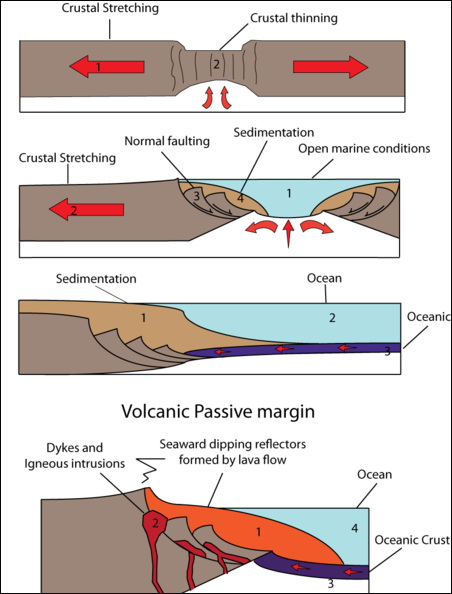
Formation of passive margins.Evidence of past rates of plate movement also can be obtained from geologic mapping studies. If a rock formation of known age — with distinctive composition, structure, or fossils — mapped on one side of a plate boundary can be matched with the same formation on the other side of the boundary, then measuring the distance that the formation has been offset can give an estimate of the average rate of plate motion. This simple but effective technique has been used to determine the rates of plate motion at divergent boundaries, for example the Mid-Atlantic Ridge, and transform boundaries, such as the San Andreas Fault.
Current plate movement can be tracked directly by means of ground-based or space-based geodetic measurements; geodesy is the science of the size and shape of the Earth. Ground-based measurements are taken with conventional but very precise ground-surveying techniques, using laser-electronic instruments. However, because plate motions are global in scale, they are best measured by satellite-based methods. The late 1970s witnessed the rapid growth of space geodesy, a term applied to space-based techniques for taking precise, repeated measurements of carefully chosen points on the Earth's surface separated by hundreds to thousands of kilometers. The three most commonly used space-geodetic techniques — very long baseline interferometry (VLBI), satellite laser ranging (SLR), and the Global Positioning System (GPS) — are based on technologies developed for military and aerospace research, notably radio astronomy and satellite tracking.
Among the three techniques, to date the GPS has been the most useful for studying the Earth's crustal movements. Twenty-one satellites are currently in orbit 20,000 km above the Earth as part of the NavStar system of the U.S. Department of Defense. These satellites continuously transmit radio signals back to Earth. To determine its precise position on Earth (longitude, latitude, elevation), each GPS ground site must simultaneously receive signals from at least four satellites, recording the exact time and location of each satellite when its signal was received. By repeatedly measuring distances between specific points, geologists can determine if there has been active movement along faults or between plates. The separations between GPS sites are already being measured regularly around the Pacific basin. By monitoring the interaction between the Pacific Plate and the surrounding, largely continental plates, scientists hope to learn more about the events building up to earthquakes and volcanic eruptions in the circum-Pacific Ring of Fire. Space-geodetic data have already confirmed that the rates and direction of plate movement, averaged over several years, compare well with rates and direction of plate movement averaged over millions of years.
Hotspots: Mantle Thermal Plumes
The vast majority of earthquakes and volcanic eruptions occur near plate boundaries, but there are some exceptions. For example, the Hawaiian Islands, which are entirely of volcanic origin, have formed in the middle of the Pacific Ocean more than 3,200 km from the nearest plate boundary. How do the Hawaiian Islands and other volcanoes that form in the interior of plates fit into the plate-tectonics picture?
Hotspot trailsIn 1963, J. Tuzo Wilson, the Canadian geophysicist who discovered transform faults, came up with an ingenious idea that became known as the "hotspot" theory. Wilson noted that in certain locations around the world, such as Hawaii, volcanism has been active for very long periods of time. This could only happen, he reasoned, if relatively small, long-lasting, and exceptionally hot regions — called hotspots — existed below the plates that would provide localized sources of high heat energy (thermal plumes) to sustain volcanism. Specifically, Wilson hypothesized that the distinctive linear shape of the Hawaiian Island-Emperor Seamounts chain resulted from the Pacific Plate moving over a deep, stationary hotspot in the mantle, located beneath the present-day position of the Island of Hawaii. Heat from this hotspot produced a persistent source of magma by partly melting the overriding Pacific Plate. The magma, which is lighter than the surrounding solid rock, then rises through the mantle and crust to erupt onto the seafloor, forming an active seamount. Over time, countless eruptions cause the seamount to grow until it finally emerges above sea level to form an island volcano. Wilson suggested that continuing plate movement eventually carries the island beyond the hotspot, cutting it off from the magma source, and volcanism ceases. As one island volcano becomes extinct, another develops over the hotspot, and the cycle is repeated. This process of volcano growth and death, over many millions of years, has left a long trail of volcanic islands and seamounts across the Pacific Ocean floor.
According to Wilson's hotspot theory, the volcanoes of the Hawaiian chain should get progressively older and become more eroded the farther they travel beyond the hotspot. The oldest volcanic rocks on Kauai, the northwesternmost inhabited Hawaiian island, are about 5.5 million years old and are deeply eroded. By comparison, on the "Big Island" of Hawaii — southeasternmost in the chain and presumably still positioned over the hotspot — the oldest exposed rocks are less than 0.7 million years old and new volcanic rock is continually being formed.
The possibility that the Hawaiian Islands become younger to the southeast was suspected by the ancient Hawaiians, long before any scientific studies were done. During their voyages, sea-faring Hawaiians noticed the differences in erosion, soil formation, and vegetation and recognized that the islands to the northwest (Niihau and Kauai) were older than those to the southeast (Maui and Hawaii). This idea was handed down from generation to generation in the legends of Pele, the fiery Goddess of Volcanoes. Pele originally lived on Kauai. When her older sister Namakaokahai, the Goddess of the Sea, attacked her, Pele fled to the Island of Oahu. When she was forced by Namakaokahai to flee again, Pele moved southeast to Maui and finally to Hawaii, where she now lives in the Halemaumau Crater at the summit of Kilauea Volcano. The mythical flight of Pele from Kauai to Hawaii, which alludes to the eternal struggle between the growth of volcanic islands from eruptions and their later erosion by ocean waves, is consistent with geologic evidence obtained centuries later that clearly shows the islands becoming younger from northwest to southeast.
Although Hawaii is perhaps the best known hotspot, others are thought to exist beneath the oceans and continents. More than a hundred hotspots beneath the Earth's crust have been active during the past 10 million years. Most of these are located under plate interiors (for example, the African Plate), but some occur near diverging plate boundaries. Some are concentrated near the mid-oceanic ridge system, such as beneath Iceland, the Azores, and the Galapagos Islands.
A few hotspots are thought to exist below the North American Plate. Perhaps the best known is the hotspot presumed to exist under the continental crust in the region of Yellowstone National Park in northwestern Wyoming. Here are several calderas (large craters formed by the ground collapse accompanying explosive volcanism) that were produced by three gigantic eruptions during the past two million years, the most recent of which occurred about 600,000 years ago. Ash deposits from these powerful eruptions have been mapped as far away as Iowa, Missouri, Texas, and even northern Mexico. The thermal energy of the presumed Yellowstone hotspot fuels more than 10,000 hot pools and springs, geysers (like Old Faithful), and bubbling mudpots (pools of boiling mud). A large body of magma, capped by a hydrothermal system (a zone of pressurized steam and hot water), still exists beneath the caldera. Recent surveys demonstrate that parts of the Yellowstone region rise and fall by as much as 1 cm each year, indicating the area is still geologically restless. However, these measurable ground movements, which most likely reflect hydrothermal pressure changes, do not necessarily signal renewed volcanic activity in the area.
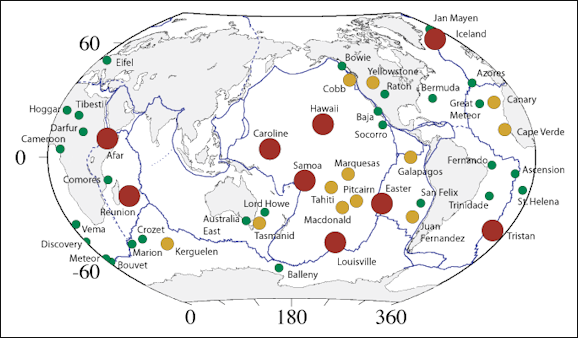
Hot spots
Earthquakes and Mountain-Building Within Plates
Philip Heron wrote in The Conversation: “The conventional theory of plate tectonics stumbles when it tries to explain some things. For example, what produces mountain ranges and earthquakes that occur within continental interiors, far from plate boundaries? The answer may lie in a map of ancient continental collisions my colleagues and I assembled. [Source: Philip Heron, Postdoctoral Fellow in Geodynamics, University of Toronto, The Conversation, July 5, 2016]
“Over the past 20 years, improved computer power and mathematical techniques have allowed researchers to more clearly look below the Earth’s crust and explore the deeper parts of our plates. Globally, we find many instances of scarring left over from the ancient collisions of continents that formed our present-day continental interiors.
“A map of ancient continental collisions may represent regions of hidden tectonic activity. These old impressions below the Earth’s crust may still govern surface processes – despite being so far beneath the surface. If these deep scarred structures (more than 30 kilometers down) were reactivated, they would cause devastating new tectonic activity. It looks like previous plate boundaries (of which there are many) may never really disappear. These inherited structures contribute to geological evolution, and may be why we see geological activity within current continental interiors.
Himalayas and Plate Tectonics
The Himalayas began to form between 40 and 50 million years ago when the Indian subcontinent climaxed a 30 million year journey across the Indian Ocean with a collision into Asia. The force and pressure of the collision between the Asian plate and India, pushed massive folds of sedimentary rock up from out of the earth. The pressure and heat of the mountain building forces turned some of rock into metamorphic rocks such schists and gneisses. Wind, rain, run off and glacial ice created the awesome Alpine shapes you see today.Much of the rock pushed upwards by the mountain building activity is limestone and sandstone that was once at the bottom of the ocean. It is possible to find fossils of sea creatures in the Himalayas at an elevation of four kilometers above sea level.
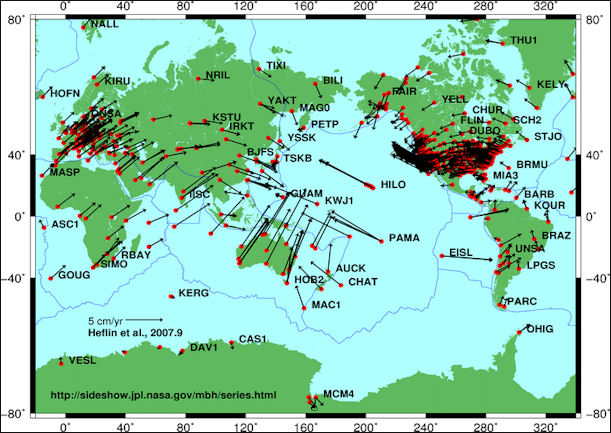
Global plate motion
Fifty kilometers north of Lhasa (the capital of Tibet), scientists found layers of pink sandstone containing grains of magnetic minerals (magnetite) that have recorded the pattern of the Earth's flip-flopping magnetic field. These sandstones also contain plant and animal fossils that were deposited when the Tethys Sea periodically flooded the region.
Himalayan rocks hold magnetic clues about their origins. Reporting from the Khardung-La road area in Ladakh, India, near long-disputed borders between India, Pakistan and China, MIT’s Craig Robert Martin wrote in the Conversation, This area contains “a narrow sinuous geological structure that stretches along the length of the Himalayan mountain range. Known as a suture zone, it’s only a few kilometers wide and consists of slivers of different types of rocks all sliced together by fault zones. It marks the boundary where two tectonic plates fused together and an ancient ocean disappeared. Our team of geologists traveled here to collect rocks that erupted as lava more than 60 million years ago. By decoding the magnetic records preserved inside them, we hoped to reconstruct the geography of ancient landmasses – and revise the story of the creation of the Himalayas. [Source: Craig Robert Martin, Ph.D. Student in Earth, Atmospheric and Planetary Sciences, Massachusetts Institute of Technology, The Conversation, November 3, 2020]
See Separate Article HIMALAYAS: HISTORY, GEOLOGY AND HIGH PEAKS factsanddetails.com
What Drives the Plates
The tectonic plates do not randomly drift or wander about the Earth's surface; they are driven by definite yet unseen forces. Although scientists can neither precisely describe nor fully understand the forces, most believe that the relatively shallow forces driving the lithospheric plates are coupled with forces originating much deeper in the Earth.
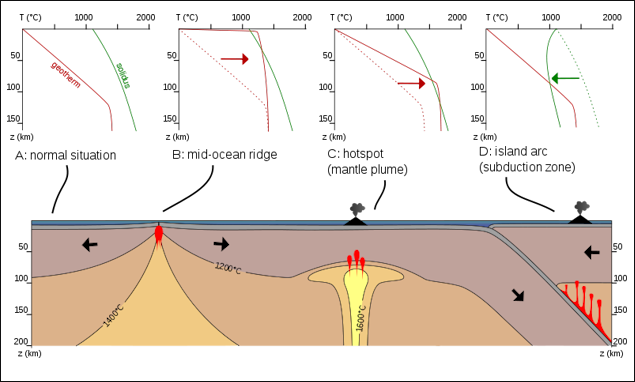
Partial melting asthenosphere
From seismic and other geophysical evidence and laboratory experiments, scientists generally agree with Harry Hess' theory that the plate-driving force is the slow movement of hot, softened mantle that lies below the rigid plates. This idea was first considered in the 1930s by Arthur Holmes, the English geologist who later influenced Harry Hess' thinking about seafloor spreading. Holmes speculated that the circular motion of the mantle carried the continents along in much the same way as a conveyor belt. However, at the time that Wegener proposed his theory of continental drift, most scientists still believed the Earth was a solid, motionless body. We now know better. As J. Tuzo Wilson eloquently stated in 1968, "The earth, instead of appearing as an inert statue, is a living, mobile thing." Both the Earth's surface and its interior are in motion. Below the lithospheric plates, at some depth the mantle is partially molten and can flow, albeit slowly, in response to steady forces applied for long periods of time. Just as a solid metal like steel, when exposed to heat and pressure, can be softened and take different shapes, so too can solid rock in the mantle when subjected to heat and pressure in the Earth's interior over millions of years.
The mobile rock beneath the rigid plates is believed to be moving in a circular manner somewhat like a pot of thick soup when heated to boiling. The heated soup rises to the surface, spreads and begins to cool, and then sinks back to the bottom of the pot where it is reheated and rises again. This cycle is repeated over and over to generate what scientists call a convection cell or convective flow. While convective flow can be observed easily in a pot of boiling soup, the idea of such a process stirring up the Earth's interior is much more difficult to grasp. While we know that convective motion in the Earth is much, much slower than that of boiling soup, many unanswered questions remain: How many convection cells exist? Where and how do they originate? What is their structure?
Convection cannot take place without a source of heat. Heat within the Earth comes from two main sources: radioactive decay and residual heat. Radioactive decay, a spontaneous process that is the basis of "isotopic clocks" used to date rocks, involves the loss of particles from the nucleus of an isotope (the parent) to form an isotope of a new element (the daughter). The radioactive decay of naturally occurring chemical elements — most notably uranium, thorium, and potassium — releases energy in the form of heat, which slowly migrates toward the Earth's surface. Residual heat is gravitational energy left over from the formation of the Earth — 4.6 billion years ago — by the "falling together" and compression of cosmic debris. How and why the escape of interior heat becomes concentrated in certain regions to form convection cells remains a mystery.
Do 2,900-Kilometer-Deep Blobs Cause Plate Tectonic Movements?
Philip Heron wrote in The Conversation: “Modern geophysical imaging also shows two chemical “blobs” at the boundary of Earth’s core and mantle – thought to possibly stem from our planet’s formation. These hot, dense piles of material lie beneath Africa and the Pacific. Located more than 2,900 kilometers below the Earth’s surface, they’re difficult to study. And nobody knows where they came from or what they do. When these blobs of anomalous substance interact with cold ocean floor that has subducted from the surface down to the deep mantle, they generate hot plumes of mantle and blob material that cause super-volcanoes at the surface. [Source: Philip Heron, Postdoctoral Fellow in Geodynamics, University of Toronto, The Conversation, July 5, 2016]
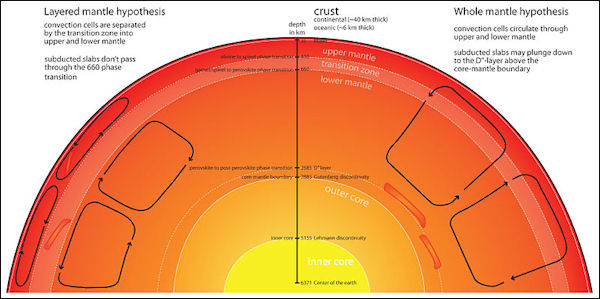
Models of mantle dynamics
And the biggest question of all remains unsolved: How did plate tectonics even begin? The early Earth’s interior had significantly hotter temperatures – and therefore different physical properties – than current conditions. Plate tectonics then may not be the same as what our conventional theory dictates today. What we understand of today’s Earth may have little bearing on its earliest beginnings; we might as well be thinking about an entirely different world.
Until the 1990s, prevailing explanations about what drives plate tectonics have emphasized mantle convection, and most earth scientists believed that seafloor spreading was the primary mechanism. Cold, denser material convects downward and hotter, lighter material rises because of gravity; this movement of material is an essential part of convection. In addition to the convective forces, some geologists argue that the intrusion of magma into the spreading ridge provides an additional force (called "ridge push") to propel and maintain plate movement. Thus, subduction processes are considered to be secondary, a logical but largely passive consequence of seafloor spreading. In recent years however, the tide has turned. Most scientists now favor the notion that forces associated with subduction are more important than seafloor spreading. Professor Seiya Uyeda (Tokai University, Japan), a world-renowned expert in plate tectonics, concluded in his keynote address at a major scientific conference on subduction processes in June 1994 that "subduction . . . plays a more fundamental role than seafloor spreading in shaping the earth's surface features" and "running the plate tectonic machinery." The gravity-controlled sinking of a cold, denser oceanic slab into the subduction zone (called "slab pull") — dragging the rest of the plate along with it — is now considered to be the driving force of plate tectonics.
We know that forces at work deep within the Earth's interior drive plate motion, but we may never fully understand the details. At present, none of the proposed mechanisms can explain all the facets of plate movement; because these forces are buried so deeply, no mechanism can be tested directly and proven beyond reasonable doubt. The fact that the tectonic plates have moved in the past and are still moving today is beyond dispute, but the details of why and how they move will continue to challenge scientists far into the future.
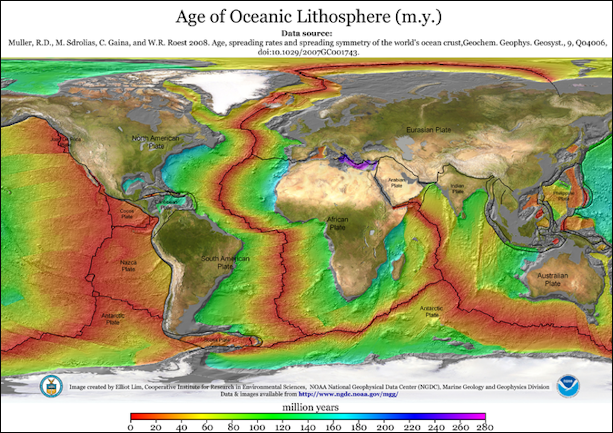
age of ocean plates on Earth
Image Sources: Wikimedia Commons, United States Geological Survey (USGS)
Text Sources: “This Dynamic Earth, The Story of Plate Tectonics” (1996) by Jaquelyne Kious and Robert I. Tilling pubs.usgs.gov United States Geological Survey (USGS), New York Times, Washington Post, Los Angeles Times, Times of London, Yomiuri Shimbun, The Guardian, National Geographic, The New Yorker, Time, Newsweek, Reuters, AP, Lonely Planet Guides, Compton’s Encyclopedia and various books and other publications.
Last updated April 2022

